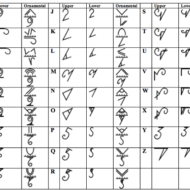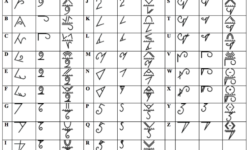Profile
Few scripts illustrate the connection between writing and cultural identity better than the Naasioi Otomaung alphabet of the Naasioi people from the Autonomous Region of Bougainville, Papua New Guinea.Once a colonial possession of Germany, Bougainville passed into Australian hands after World War I, briefly being held by Japan and the US during World War II before being taken over by Australia again in 1946. A pivotal development was the establishment, in the face of local opposition, of a copper mine (at the time, the largest open cut mine in the world) that caused devastating environmental damage. Local Bougainvilleans were angered at the influx of workers who were culturally different, and the exodus of mine profits leaving the island. The result was secessionist activity that ultimately led to Papua New Guinea gaining independence from Australia in 1975.
The new government was no improvement for the Bougainvillians: despite their protests, the mine’s operations continued. From 1988-98 there was outright war; from 1990 to 1994 the Papua New Guinea government used patrol boats and helicopter gunships to impose a total blockade on the island, and neither people nor goods were permitted to land or leave.
“The blockade produced enormous hardship,” Piers Kelly writes in the first published account of the alphabet, “but it also became a catalyst for extraordinary innovation to ensure survival and self–sufficiency. Among other initiatives, local communities repurposed abandoned mine equipment to create home¬made hydroelectric power plants, and produced their own biodiesel from coconuts to keep vehicles running. These technological innovations and initiatives reinforced the idea that Bougainville was quite capable of autonomy and that genuine independence was within reach.”
One of these initiatives was the establishment of the Otomaung cultural organization, whose founder and leader, Chief Peter Karatapi, created the Naasioi Otomaung alphabet.
The word “Otomaung” has multiple meanings. Roughly equivalent to the phase “able to express anything,” it refers to the religious/cultural movement and also the alphabet itself, which was designed to be usable for any language—and also the letter A.
The alphabet itself has some remarkable features. The forms of the letters are said to have been inspired by the island tradition of ceremonial scarring, so writing the letters in itself becomes an act of cultural preservation.
Each character maps to a letter in the Latin alphabet, but in Naasioi Otomaung there are three typographic “registers” that correspond to uppercase, lowercase and a third “ornamental” register. The ornamental version consists of the lowercase version, above which the writer adds a horizontal bar with a horizontal row of five dots above it, then caps off the glyph with a graphic decoration, looking oddly like part of a geometry problem, that is entirely independent of phonetic or semantic value.
At one point, the Otomaung movement advocated the establishment of a culturally authentic and independent education system for Naasioi speakers: Naasioi language was taught instead of English, traditional religion replaced Catholicism, and literacy instruction up to third grade took place in the Naasioi Otomaung alphabet. Even so, today the script has few habitual users, though it can be seen on T-shirts, fans, and political banners, and Keely reports that its users are hoping to promote a greater role for it in a future independent Bougainville.
You can help support our research, education and advocacy work. Please consider making a donation today.

